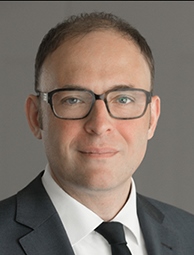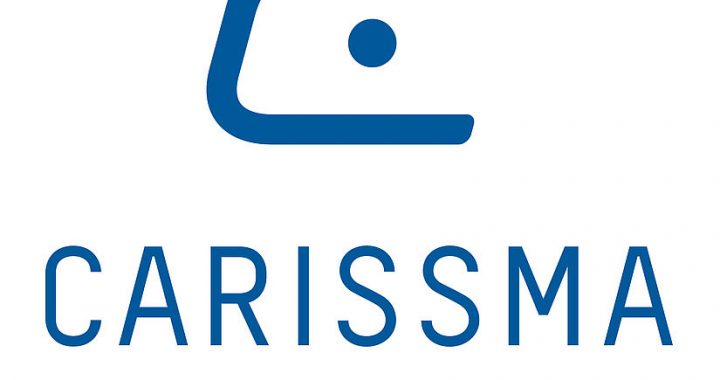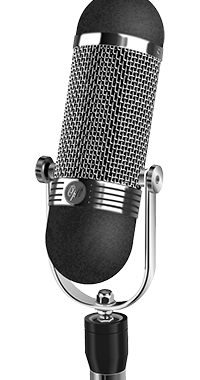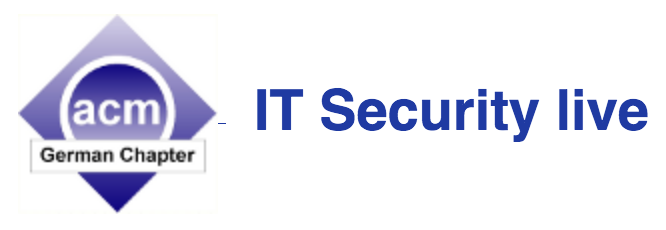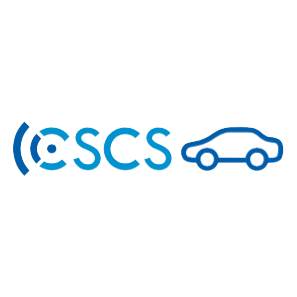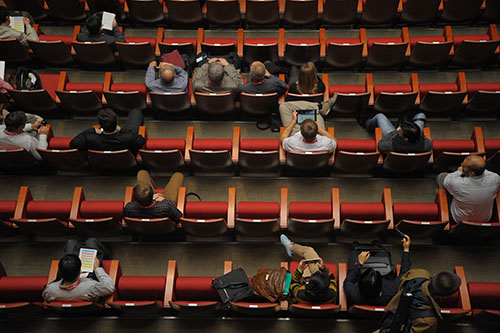Professor Hof und seine Forschungsgruppen INSicherheit – Ingolstädter Forschungsgruppe Angewandte IT-Sicherheit und MuSe – Munich IT Security Research Group sind Sponsoren der “The Eleventh International Conference on Emerging Security Information, Systems and Technologies – SECURWARE 2017” welche vom 10.09.-14.09.2017 in Rom stattfindet. Die Einreichefrist wurde bis 25.05. verlängert, den CfP finden Sie hier: Link.
Weitere Informationen:
SECURWARE 2017, The Eleventh International Conference on Emerging Security Information Systems and Technologies, is an event covering related topics on theory and practice on security, cryptography, secure protocols, trust, privacy, confidentiality, vulnerability, intrusion detection and other areas related to low enforcement, security data mining, malware models, etc.
Security, defined for ensuring protected communication among terminals and user applications across public and private networks, is the core for guaranteeing confidentiality, privacy, and data protection. Security affects business and individuals, raises the business risk, and requires a corporate and individual culture. In the open business space offered by Internet, it is a need to improve defences against hackers, disgruntled employees, and commercial rivals. There is a required balance between the effort and resources spent on security versus security achievements. Some vulnerability can be addressed using the rule of 80:20, meaning 80% of the vulnerabilities can be addressed for 20% of the costs. Other technical aspects are related to the communication speed versus complex and time consuming cryptography/security mechanisms and protocols.
Digital Ecosystem is defined as an open decentralized information infrastructure where different networked agents, such as enterprises (especially SMEs), intermediate actors, public bodies and end users, cooperate and compete enabling the creation of new complex structures. In digital ecosystems, the actors, their products and services can be seen as different organisms and species that are able to evolve and adapt dynamically to changing market conditions.
Digital Ecosystems lie at the intersection between different disciplines and fields: industry, business, social sciences, biology, and cutting edge ICT and its application driven research. They are supported by several underlying technologies such as semantic web and ontology-based knowledge sharing, self-organizing intelligent agents, peer-to-peer overlay networks, web services-based information platforms, and recommender systems.
To enable safe digital ecosystem functioning, security and trust mechanisms become essential components across all the technological layers. The aim is to bring together multidisciplinary research that ranges from technical aspects to socio-economic models.
As a multi-track event, SECURWARE 2017 will serve as a forum for researchers from the academia and the industry, professionals, standard developers, policy makers and practitioners to exchange ideas. The topics could be on techniques and applications, best practices, awareness and experiences as well as future trends and needs (both in research and practices) related to all aspects of information security, security systems and technologies.
SECURWARE 2017 has the following tracks:
TRENDS: Security challenges with new technologies
SECSERV: Security-as-a-Service – Security technologies and systems-oriented security and safety
SECSTATUS: Advances and Challenges
SERVICES: Cyber Laboratory Services
SOLUTIONS: Cyber Laboratory Solutions
ARCH: Security frameworks, architectures and protocols
METRICS: Security, trust and privacy measurement
SECMAN: Security management
SECTECH: Security technologies
SYSSEC: System security
INFOSEC: Information security
RISK: Risk and security
MALWA: Malware and Anti-malware
ANTIFO: Anti-forensics
PRODAM: Profiling data mining
SECHOME: Smart home security
SECDYN: Security and privacy in dynamic environments
ECOSEC: Ecosystem security and trust
CRYPTO: Cryptography
CYBER-Threat
We solicit both academic, research, and industrial contributions. We welcome technical papers presenting research and practical results, position papers addressing the pros and cons of specific proposals, such as those being discussed in the standard fora or in industry consortia, survey papers addressing the key problems and solutions on any of the above topics short papers on work in progress, and panel proposals.
Industrial presentations are not subject to the format and content constraints of regular submissions. We expect short and long presentations that express industrial position and status.
Tutorials on specific related topics and panels on challenging areas are encouraged.
The topics suggested by the conference can be discussed in term of concepts, state of the art, research, standards, implementations, running experiments, applications, and industrial case studies. Authors are invited to submit complete unpublished papers, which are not under review in any other conference or journal in the following, but not limited to, topic areas.
All topics and submission formats are open to both research and industry contributions.
TRENDS: Security challenges with new technologies
Security in SDN, SDX, NFV
Security in 4G/5G networks
Security and Internet of X (everything, things, people, etc.)
Security for Virtualization and Cloud
Security and Big Data
Security in sensing and sensor networks
Security and energy-aware networks
Security in content-oriented networking
Security in cellular cognitive networks
SECSERV: Security-as-a-Service – Security technologies and systems-oriented security and safety
Certified services and businesses
Security certifying processes, technologies and standards
Industrial security
Security in information systems
Physical/Virtual/Cloud security
Corporate/Personal security
Security guarantee/assurance/risks
Surveillance systems
Security/Safety digital environments (electromagnetic waves, unsafe facilities, undocumented logistics, etc.)
Cyber-security and public services risks (thefts, health, alarms, vehicular, surveillance, people with special needs, credit carts, use of arms, drone-based delivery, etc.)
Security in supply-based systems
Security in mobile applications, Web-based, Cloud-based services, and Internet of Things (IoT)-based systems
Designing secure and green-oriented industrial systems
Security in production systems
Secure production lines and secure human-oriented products and services
SECSTATUS: Advances and Challenges
Cryptography
Encryption schemes
Cryptanalysis
Thrifty zero-knowledge approaches
Chaos-information hiding
Advances in biometric authentication
Passive forensics
Access, computation and communication security mechanisms
Secure error-tolerant protocols
Side-channel attacks
Malware and attacks prevention
Anti-analysis signals
Security-awareness
Culture-oriented prevention
Security for smart devices
Security for mobile applications
Anonymity and pseudo-anonymity
Mitigating threats
Privilege control and isolation
Cyber-attacks and human factors
IoT and big data security issues
Privacy and protection in eTechnologies
Secure virtualized environments
Security during system migration or updates
Security integration pitfalls
Data leakage, vulnerabilities, failures and lessons learned
Security standards
SERVICES: Cyber Laboratory Services
Cyber intelligence systems
Global defense
Security-awareness
Data sanitization and end-of-lifecycle solutions
Compliance solutions with PCI DSS standard from PCI DSS certified datacenters
Mobile Device Management (MDM) and Mobile Application Management (MAM)
Identity and Access Management (IAM)
Risk and security management
IT-Governance, Risks and compliance
Public safety and professional communications and solutions for situational awareness, command and control
Data security services
SOLUTIONS: Cyber Laboratory Solutions
Cyber intelligence technologies
Global threat correlation and reputation services; credentials, expiration time for client installations, feature restrictions, Web-console audit logging, etc.
Advanced testing software, for known and unknown flaws in software; identifying the weaknesses and vulnerabilities
E-mail communication confidentiality protection
Protect of enterprises and government agencies for their confidential data against leaks
Internet security and content cloud services
Risk and security management
IT-Governance, Risks and compliance
SCADA-based information security systems
Guideline on advising, building, developing and inspecting/auditing
information security practices and systems
ARCH: Security frameworks, architectures and protocols
Formal aspects of security
Security analysis methodologies
Security verification
Security protocols
Security architectures and formalisms
Security and design vulnerability
Security and privacy protection
Performance and security
Secure group communication/multicast
Software design security
Middleware security
Security for nomadic code
Intrusion detection systems
Static analysis for software security
Security modeling
METRICS: Security, trust and privacy measurement
Security, trust and privacy metrics;
Security assurance metrics
Security measurement architectures
Metrics for adaptive security systems
Taxonomical and ontological support of security metrics
Experiments and benchmarks for security measurements
Embedding security measurability in software and service architectures
Risk-driven assessment of security
Assessment of effectiveness, efficiency and correctness of security
Mapping security metrics and security assurance metrics
Mapping security measurements and non-functional requirements
SECMAN: Security management
Identity management
Security law enforcement
PKI
PKI Key management
Incident response planning
Intrusion detection and event correlation
Firewalls
Trust management
Software security assurance
SECTECH: Security technologies
Secure protocols
Applied cryptography
Smart cards
Biometrics
Digital rights management
Electronic surveillance
Database security
SYSSEC: System security
Internet security
Security in wireless
Sensor/cellular network security
Ad hoc network security
Security in peer-to-peer networks
Security in wireless multimedia systems
Security in different networks (mesh, personal, local, metropolitan, GSM, Bluetooth, WiMax, IEEE 802.x, etc.)
Security of emergency services
INFOSEC: Information security
Information hiding
Anonymity
Authentication
Data Integrity
Security data mining
Data confidentiality and integrity
Information flow protection
Trustworthy networks: authentication, privacy and security models
Secure service discovery
Secure location-based service
Information survivability
RISK: Risk and security
Operational risk (opRisk)
OpRisk and field studies
Reputation risk
Risk and security-awareness
Business continuity and disaster recovery
Privacy-awareness
Security and trust
MALWA: Malware and Anti-malware
Threat taxonomies and modeling
Security threats
Threats propagation
Anti-malware technologies
Engineering anti-malware
Anti-virus, anti-spyware, anti-phishing
Malware propagation models
Profiling security information
Vulnerability analysis and countermeasures
Denial of service attacks
Measurements and metrics
Testing samples and techniques
Quarantine/reuse decisions
Anti-malware tool performance
Anti-malware tool suites
Open-source anti-malware
Host-based anti-malware
On-line anti-malware scanning
Messaging, viruses, spyware
Advanced misuse detection techniques /machine learning, natural language processing, challenge-response, etc./
Message filtering, blocking, authentication
Digital signatures
Generalized spamming /over email, Internet telephony, instant messaging, mobile phone, phishing, etc. /
Spam compression and recognition
Learning misuse patterns
Payment schemes
Economics of generalized spam
Tracking abuse tactics and patterns
Protecting legitimate use patterns
Methods for testing protection robustness
Costs and benefits of messaging use and misuse
Standards for messaging and misuse reporting
Legal aspects /identity theft, privacy, freedom of speech, etc./
ANTIFO: Anti-forensics
Advanced anti-forensics mechanisms
Smart anti-forensics
e-discovery industry and anti-forensics
Overwriting data and metadata
Data hiding approaches
Detecting forensics analysis
Anti-forensics tools
Unix-, Windows-, and Linux anti-forensics techniques
Open source anti-forensics tools
Network anti-forensics tools
PRODAM: Profiling data mining
User and traffic profiling
Data mining and visualization
Profile mining and knowledge discovery
Mining lifecycle for profile collections
Profile warehouse construction
Profile portfolio and profile discovery
Profiling game users and game traffic
Profiling transactions
Simpson’d paradox
Real-time profiling mechanisms
Patterns for information profiling
Profiling engines
Profiling metrics
Forensics
Profiling applications (banks, on-line shopping, etc.)
Data mining-based user profile prediction
SECHOME: Smart home security
Fundamentals for SHS
Privacy and protection for SHS
Identify and location management in SHS
Authentication and authorization in SHS
Access control and security policies in SHS
Trust and reputation management
Security context-based interfaces for SHS
SHS for accessibility and elderly/disabled people
Real-time challenges for SHS in eHealth environments
Architectures and systems for SHS
Network technologies and protocols for SHS
Ubiquitous/pervasive platform and middleware for SHS
Services and applications for SHS
SHS on campuses and hotels
SHS for mission critical laboratories
Content protection and digital rights management for SHS
Intelligent devices, sensor network/RFID for SHS
Intrusion detection and computer forensics for SHS
SHS and Homeland security
Personal data privacy and protection in SHS
Emerging standards and technologies for SHS
Commercial and industrial for SHS
Case studies, prototypes and experience
SECDYN: Security and privacy in dynamic environments
Fundamentals on highly dynamic environments
Privacy and predefined access control dilemma
Privacy police, provisions and obligations
Dependability in dynamic environments
Protection of digital documents in dynamic environments,
On-line activities in high dynamic systems
Law enforcement in high dynamic systems
Personalization
Privacy and transparency
Distributed usage control
Privacy compliance
Secure ambient intelligence
Secure embedded microprocessor architectures
Secure compilation techniques
ECOSEC: Ecosystem security and trust
Secure and trusted service compositions in peer-to-peer networks
Secure data management in collaborative peer-to-peer networks
Security and reputation models for self-adaptive overlay networks
Identity and trust management in dynamic, self-organizing environments
Social institutional-based trust models for self-evolving communities
CRYPTO: Cryptography
Foundations of cryptography
Applied cryptography
Cryptanalysis
Signatures schemes and trust models
Cryptographic algorithms
Electronic payment systems
High-performance encryption methods
Group-oriented cryptography
Identity-based cryptography
Anonymous authentication
Cryptography for multi-user environments
Cryptography and secure localization systems
Attacks on cryptosystems
CYBER-Threat
e-Crime
Epidemiological models for warware and cyber-crime propagation
Record and retrieval of cyber-crimes
Cyber-crime prevention
Cyber-crime vulnerabilities
Cyber-counterattack at source
Distributed cyber-attacks
Orchestrated cyber-attacks
Recursion attacks
Cyber-storm attacks
Cyber-pranks, hoaxes
Phishing/Pharming and anti-phishing
Cyber-terrorism
Online cyber-crime reporting
Accuracy and security of cyber-reports
Fighting cyber-crimes
Cyber-crime laws
INSTRUCTION FOR THE AUTHORS
Authors of selected papers will be invited to submit extended versions to one of the IARIA Journals.
Publisher: XPS (Xpert Publishing Services)
Archived: ThinkMindTM Digital Library (free access)
Prints available at Curran Associates, Inc.
Articles will be submitted to appropriate indexes.
Important deadlines:
| Submission (full paper) |
April 25 May 25, 2017 |
| Notification |
June 25, 2017 |
| Registration |
July 10, 2017 |
| Camera ready |
July 27, 2017 |
Only .pdf or .doc files will be accepted for paper submission. All received submissions will be acknowledged via an automated system.
Contribution types
- regular papers [in the proceedings, digital library]
- short papers (work in progress) [in the proceedings, digital library]
- ideas: two pages [in the proceedings, digital library]
- extended abstracts: two pages [in the proceedings, digital library]
- posters: two pages [in the proceedings, digital library]
- posters: slide only [slide-deck posted on www.iaria.org]
- presentations: slide only [slide-deck posted on www.iaria.org]
- demos: two pages [posted on www.iaria.org]
- doctoral forum submissions: [in the proceedings, digital library]
Proposals for:
FORMATS
Only .pdf or .doc files will be accepted for paper submission. All received submissions will be acknowledged via an automated system.
Final author manuscripts will be 8.5″ x 11″, not exceeding 6 pages; max 4 extra pages allowed at additional cost. The formatting instructions can be found on the Instructions page. Helpful information for paper formatting can be found on the here. Latex templates are also available.
Slides-based contributions can use the corporate/university format and style.
Your paper should also comply with the additional editorial rules.
Once you receive the notification of contribution acceptance, you will be provided by the publisher an online author kit with all the steps an author needs to follow to submit the final version. The author kits URL will be included in the letter of acceptance.
We would recommend that you should not use too many extra pages, even if you can afford the extra fees. No more than 2 contributions per event are recommended, as each contribution must be separately registered and paid for. At least one author of each accepted paper must register to ensure that the paper will be included in the conference proceedings and in the digital library, or posted on the www.iaria.org (for slide-based contributions).
CONTRIBUTION TYPE
Regular Papers (up to 6-10 page article -6 pages covered the by regular registration; max 4 extra pages allowed at additional cost- ) (oral presentation)
These contributions could be academic or industrial research, survey, white, implementation-oriented, architecture-oriented, white papers, etc. They will be included in the proceedings, posted in the free-access ThinkMind digital library and sent for indexing. Please submit the contributions following the instructions for the regular submissions using the “Submit a Paper” button and selecting the appropriate contribution type. 12-14 presentation slides are suggested.
Short papers (work in progress) (up to 4 pages long) (oral presentation)
Work-in-progress contributions are welcome. These contributions represent partial achievements of longer-term projects. They could be academic or industrial research, survey, white, implementation-oriented, architecture-oriented, white papers, etc. Please submit the contributions following the instructions for the regular submissions using the “Submit a Paper” button and selecting the contribution type as work in progress. Contributors must follow the conference deadlines, describing early research and novel skeleton ideas in the areas of the conference topics. The work will be published in the conference proceedings, posted in the free-access ThinkMind digital library and sent for indexing. For more details, see the Work in Progress explanation page. 12-14 presentation slides are suggested.
Ideas contributions (2 pages long) (oral presentation)
This category is dedicated to new ideas in their very early stage. Idea contributions are expression of yet to be developed approaches, with pros/cons, not yet consolidated. Ideas contributions are intended for a debate and audience feedback. Please submit the contributions following the instructions for the regular submissions using the “Submit a Paper” button and selecting the contribution type as Idea. Contributors must follow the conference deadlines, describing early research and novel skeleton ideas in the areas of the conference topics. The work will be published in the conference proceedings, posted in the free-access ThinkMind digital library and sent for indexing. For more details, see the Ideas explanation page. 12-14 presentation slides are suggested.
Extended abstracts (2 pages long) (oral presentation)
Extended abstracts summarize a long potential publication with noticeable results. It is intended for sharing yet to be written, or further on intended for a journal publication. Please submit the contributions following the instructions for the regular submissions using the “Submit a Paper” button and selecting the contribution type as Extended abstract. Contributors must follow the conference deadlines, describing early research and novel skeleton ideas in the areas of the conference topics. The work will be published in the conference proceedings, posted in the free-access ThinkMind digital library and sent for indexing. 12-14 presentation slides are suggested.
Posters (paper-based, two pages long) (oral presentation)
Posters are intended for ongoing research projects, concrete realizations, or industrial applications/projects presentations. The poster may be presented during sessions reserved for posters, or mixed with presentation of articles of similar topic. A two-page paper summarizes a presentation intended to be a POSTER. This allows an author to summarize a series of results and expose them via a big number of figures, graphics and tables. Please submit the contributions following the instructions for the regular submissions using the “Submit a Paper” button and selecting the contribution type as Poster Two Pages. Contributors must follow the conference deadlines, describing early research and novel skeleton ideas in the areas of the conference topics. The work will be published in the conference proceedings, posted in the free-access ThinkMind digital library and sent for indexing. 8-10 presentation slides are suggested. Also a big Poster is suitable, used for live discussions with the attendees, in addition to the oral presentation.
Posters (slide-based, only) (oral presentation)
Posters are intended for ongoing research projects, concrete realizations, or industrial applications/projects presentations. The poster may be presented during sessions reserved for posters, or mixed with presentation of articles of similar topic. The slides must have comprehensive comments. This type of contribution only requires a 8-10 slide-deck. Please submit the contributions following the instructions for the regular submissions using the “Submit a Paper” button and selecting the contribution type as Poster (slide-only). The slide-deck will be posted, post-event, on www.iaria.org.
8-10 presentation slides are suggested. Also a big Poster is suitable, used for live discussions with the attendees, additionally to the oral presentation.
Presentations (slide-based, only) (oral presentation)
These contributions represent technical marketing/industrial/business/positioning presentations. This type of contribution only requires a 12-14 slide-deck. Please submit the contributions following the submission instructions by using the “Submit a Paper” button and selecting the contribution type as Presentation (slide-only). The slide-deck will be posted, post-event, on www.iaria.org.
12-14 presentation slides are suggested.
Demos (two pages) [posted on www.iaria.org]
Demos represent special contributions where a tool, an implementation of an application, or a freshly implemented system is presented in its alfa/beta version. It might also be intended for thsoe new application to gather the attendee opinion. A two-page summary for a demo is intended to be. It would be scheduled in special time spots, to ensure a maximum attendance from the participants. Please submit the contributions following the submission instructions by using the “Submit a Paper” button and selecting the contribution type as Demos. The Demos paper will be posted, post-event, on www.iaria.org.
Doctoral forum submissions: (up to 6-10 page article -6 pages covered the by regular registration; max 4 extra pages allowed at additional cost- ) (oral presentation)
There contributions refer to PhD dissertations, new PhD approaches, and PhD out-of-the-book thinking, etc. They will be included in the proceedings, posted in the free-access ThinkMind digital library and sent for indexing. Please submit the contributions following the instructions for the regular submissions using the “Submit a Paper” button and selecting the appropriate contribution type Doctoral forum. 12-14 presentation slides are suggested.
Tutorial proposals
Tutorials provide overviews of current high interest topics. Proposals should be for 2-3 hour long. Proposals must contain the title, the summary of the content, and the biography of the presenter(s). The tutorials’ slide decks will be posted on the IARIA site.
Please send your proposals to tutorial proposal
Panel proposals
The organizers encourage scientists and industry leaders to organize dedicated panels dealing with controversial and challenging topics and paradigms. Panel moderators are asked to identify their guests and manage that their appropriate talk supports timely reach our deadlines. Moderators must specifically submit an official proposal, indicating their background, panelist names, their affiliation, the topic of the panel, as well as short biographies. The panel’s slide deck will be posted on the IARIA site.
Please send your proposals to panel proposal
Workshop proposals
See http://www.iaria.org/workshop.html
Mini Symposium proposal
See http://www.iaria.org/symposium.html



